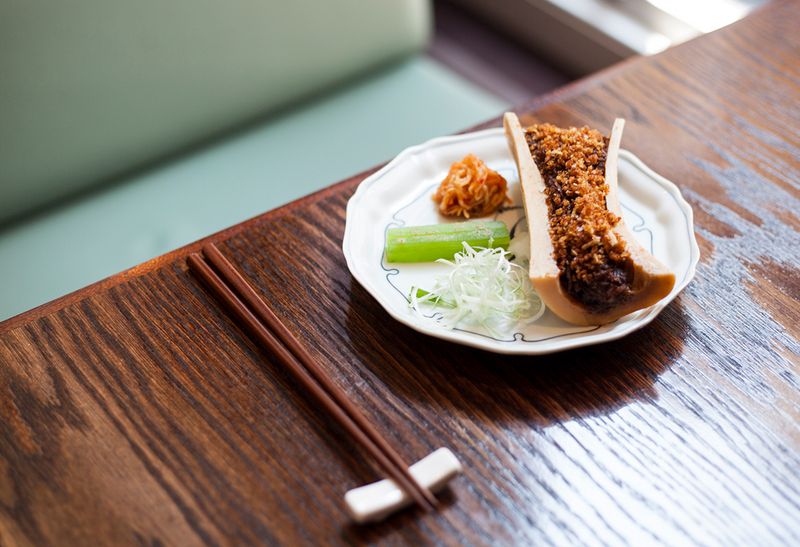THE JOURNAL

Beef pancake at Xu. Photograph by Ms Carol Sachs, courtesy of Xu
We dust off our chopsticks and go on a culinary voyage of discovery.
London is waking up to the nuances of Chinese food. Since the first generation of oriental restaurants opened in the 1970s, focusing on a Cantonese style of cuisine (sickly-sweet sauces, MSG and an affinity with the deep-fat fryer), the city has come a long way in its appreciation of Eastern food. In China, a country that covers nearly 4 million square miles with a population of 1.4 billion, there are nearly as many versions of its kitchen as there are people.
As a rough guide, the further inland and harsher the terrain, you’ll find more dried chilli, fewer vegetables and meat used sparingly. In northern China and close to Mongolia, the Xinjiang province offers a style of food that is hard to come across in London, unless you are familiar with the simply fantastic Silk Road in Camberwell. Here, skewered lamb and lamb fat is dry rubbed to within an inch of its life with fiery pepper paste and flamed over a spitting charcoal grill. Smacked cucumber makes a natural cooling tonic and foot-rolled noodles (arrive early in the service to watch the staff in action) are dense with a texture that begs to soak up sauce.

Left: A.Wong. Right: Yunnan beef. Photograph by Mr John Carey, courtesy of A.Wong
A restaurant that’s picking up awards left, right and centre at the moment for a more refined brand of Chinese food is A.Wong in Victoria. Chef Mr Andrew Wong studied anthropology at the London School of Economics, before setting off on a culinary journey across China and returning to England to take the reins of the restaurant from his father. Each of the 10 courses on his Taste of China menu looks at a different style of regional cookery. Chengdu tofu is a true incarnation of southwestern Sichuan street food (characterised by bold flavours, garlic and chilli), scallop puff displays the east of the country’s love of shellfish, while Yunnan cheese (think: halloumi) proves that the Chinese, a famously lactose-loathing race, can produce cheese of a good quality, too. For a one-meal, region-hopping education into how varied Chinese food can be, A.Wong is the perfect place to start.

Left: Hakkasan. Right: dim sum. Photographs courtesy of Hakkasan Hanway
One of the first brands to bring high-end Chinese food to the UK and, indeed, the world is Hakkasan, which opened in 2001. It’s the brainchild of Mr Alan Yau (who also owns Wagamama, Park Chinois and Yauatcha) and was the first Chinese restaurant in the UK to receive a Michelin star at its Hanway Place site in 2003. With its inception, it created a new breed of Cantonese cuisine. Dishes such as silver cod in champagne and Peking duck with beluga caviar are just as decadent as they sound. By fusing traditional technique with luxury ingredients, it brought Chinese food in line with the 2000s movement for haute cuisine, and London lapped it up. Sixteen years on, it still leads the way in global innovation for modern Chinese food, using in-vogue ingredients and contemporary cooking processes.

Left: Xu. Right: chilli egg drop crab. Photographs by Ms Carol Sachsc, courtesy of Xu
If you could pick something edible that the whole of China recognises, it might be baozi, a steamed bun. The recipe for the doughy casing remains similar from east to west, but its contents will offer a clue as to its genesis. Cha siu bao uses the smoky and sweet barbecued pork popular in the Guangdong province and Hong Kong, while goubuli baozi is a medley of different meats served in Tianjin, in the north of the country. In a story similar to the heritage of our own Cornish pasties, manual workers would take them for lunch, using the robustness of the casing as protection for the filling and as carbohydrate-heavy ballast for long days spent mining. It took a while for them to reach the West, and Soho’s Bao was the first restaurant to bring them to London. Bao’s food focuses on the sweet, sticky flavours of Taiwan and southeast China. Starting life as a street-food stall, the team have recently opened their third restaurant, Xu, which is a more upmarket incarnation of the flavours of the region.
Scratch the surface and there’s a style of Chinese cuisine to suit every palate. Some of it is spicy, some of it cooling and the vast majority of it truly delicious. And the best thing? London is one of the finest cities in the world to discover it all.
ADD SOME FLAVOUR
Keep up to date with The Daily by signing up to our weekly email roundup. Click here to update your email preferences